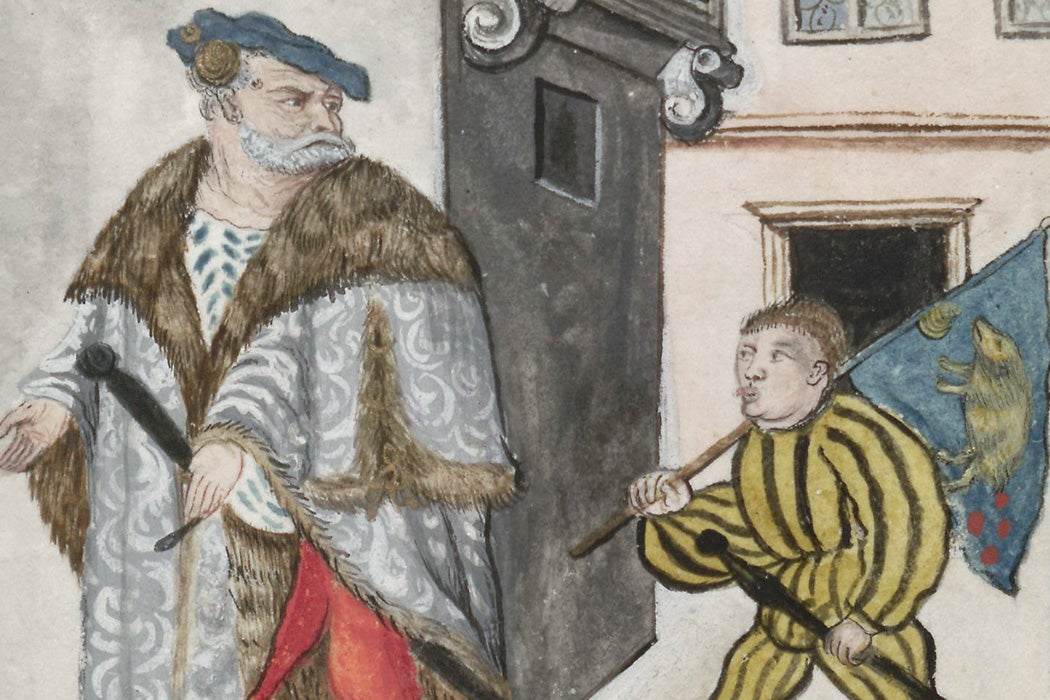The well-dressed Renaissance figure was, argues historian Ulinka Rublack, a work of art, a form of “polychrome sculpting.” Fashion, she continues, is “as important as painting for understanding the Renaissance as an aesthetic movement.”
Even artists such as Benevenuto Cellini understood the process of embedding a model in a mold for casting a bronze statue as “clothing” the core in earth. A “sense of tailoring as akin to sculpture and sculpting as resonant with dressing was embedded in a culture whose entire economy and everyday life were tightly interlinked with an ever increasing spectrum of textiles,” writes Rublack.
It was a spectrum of textiles and colors. Rublack quotes art historian Michael Baxandall, who describes the surfaces of polychromatic limewood sculptures as “resonant with the marvelous gamut of Renaissance textile surface—satin, damask, camlet, velvet, silk, taffeta, tabby, brocade.” These materials, Rublack writes, called for “astonishing achievements in skill, imagination, and dexterity.”
“Royal, imperial, or papal” costumes highlighted the “magnificence of key figures through the fantastic wealth of their jewelry, silk garments, or fabrics made from gold or silver thread,” Rublack explains. The “luminescent splendor” of sacred art translated to the “embodiments of secular power.” Merchants wanted in on the glory, too. Gleaming, bright, reflective surfaces of “gold mosaics, glass windows, bejeweled reliquaries” had their counterparts on the light-reflecting properties of fabrics and vivid dyes. A fifteenth-century Sforza prince would have his clothed body compared to a “living sun.”
While Spanish Catholicism and reformatory Protestantism favored black clothing, the sixteenth century saw an explosion of the spectrum of color available for dying fabric. The New World didn’t just provide gold, silver, and fascinating new foods; there were all sorts of potential dyes as well. These source materials weren’t just minerals or plants: cochineal, or carmine red, the color of cardinals and Redcoats, came from the crushed bodies of cactus-feeding insects. Gioanventura Rosetti’s Plictho (1548), a groundbreaking manual on dye-making and leather tanning, included hundreds of recipes for colors.
“This was a society intimately involved with how things were made and what they were made from,” writes Rublack. One of the most extraordinary records of Northern European fashion of the sixteenth century is Matthäus Schwarz’s Klaidungsbüchlein or the Little Book of Clothes. This is an illustrated memoir in costumes, documenting what he wore from infancy to old age. “A loyal Catholic bourgeois,” Schwarz (1497–c. 1574) was an accountant for Jakob Fugger (one of the wealthiest people in Europe), and consciously used clothing to maintain, if not better, his position in society. With its 137 vivid images, the book has been hailed as the The First Book of Fashion.
Rublack and Maria Hayward put together the first English edition of Schwarz’s book. Part of the project was the commissioning of Jenny Tiramani of the London School of Historical Dress to make an interpretation of the bold red and yellow outfit Schwarz wore to the 1530 Imperial Diet in Augsburg.
The “collaborative process immediately made clear that to create such an outfit was a notable achievement in aesthetic production,” writes Rublack. (The book includes Tiramani’s bespoke pattern for contemporary makers; Rublack’s article includes pictures of the making and fitting.) Replicating the golden-yellow color of Schwarz’s deerskin hose (and sourcing from hides without the holes left by ticks) was just the first challenge. Initial efforts weren’t vibrant enough.
Weekly Newsletter
“In Schwarz’s time, such faded hues of yellow could have negative associations of weakness and coldness, which is why they were used to stigmatize Jews,” Rublack notes. Color was as ideological as aesthetic.
Rublack describes the reproduction of Schwarz’s black hat, which wouldn’t have looked out of place atop Buster Keaton, writing that
like the doublet, the wide-rimmed plate bonnet wound up requiring further stiffening, with cotton, linen or animal hair, to perfectly stay in shape. It was tightly knit with fine merino-wool yarn on very thin needles to achieve a high stitch count and density of fabric. Then it was dyed and fulled with rough repeated immersion in hot, soapy water and repeated beating with a mallet as well as kneading and rolling.
The very influential religious/political maneuvering of that 1530 Imperial Diet in Augsburg, in which what attendees wore “was used symbolically to affect political strategies,” would make a hell of a miniseries—with much of the budget going to the costumes.
Support JSTOR Daily! Join our membership program on Patreon today.







